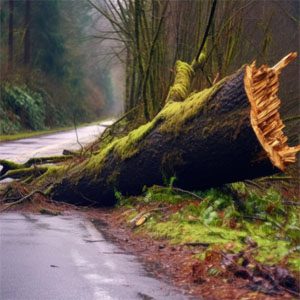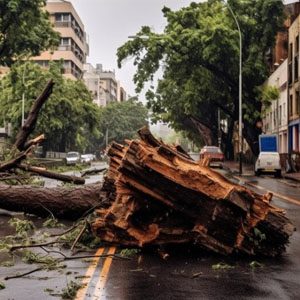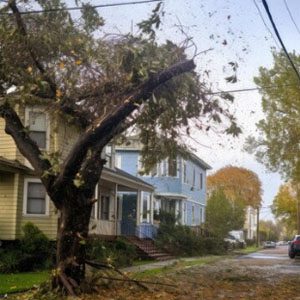
There are many circumstances in which a tree must fall. However, proper maintenance can extend the life of your beloved shade maker.
Here is a list of what to look for in New York to help you maintain a tree-related emergency.
 Check the tree roots
Check the tree roots
If tree roots threaten the structure of your home, you should contact a certified arborist and provide advice on the best way to prune the roots without harming the tree’s health. Tree roots are powerful enough to pierce the foundation of a house and destroy it. A rough rule of thumb for measuring the length of a tree’s roots is called a growth line. If the branches of a tree can reach the roof or walls of a building, so can the roots.
Then check the roots for signs of rot.
Some signs include:
✓ Canopy thins as trees gradually die
✓ Branch will die
✓ Withered leaves
✓ Slowing growth
✓ Ulcers or depressions on the stem indicate that root rotting fungi are making their way through the tree.
✓ Mushrooms around tree trunks, root flares or drips, especially armillaria
Even if you see green leaves on the branches, the tree will not live long if the roots are rotten. A tree’s roots provide structural support, and once weakened, it is only a matter of time before the tree topples. Ask a reputable tree management company to prune your tree to prevent it from falling in the wrong direction at the wrong time.
Even if there is no rot, mold can develop. If you see mushrooms still growing at the base of your tree, you may be experiencing root disease. While this is not a sure sign, you should have your tree inspected by a certified arborist. If it is determined that the roots of the tree are indeed diseased, the tree must be removed.
 Look for other signs of disease
Look for other signs of disease
Trees with lots of discolored leaves, odd lumps on the bark, and early defoliation can cause tree disease. Trees do not have strong roots, so they fall much more easily when sick. The tree must be felled immediately to close the possibility.
Scan the tree for dead branches
A large dead branch on a tree poses a great danger. Strong winds can collapse buildings and damage everything in their path cars, bicycles, fences, sheds, houses. Annual inspection and trimming, especially weight reduction, can help prevent severe storm damage by making trees stronger.
Look at the weird tilt
A leaning tree is not dangerous if the tree is facing its natural direction. However, if you notice that your tree is leaning in a new direction, or that the tree that was originally leaning is now leaning more, you may need to contact a professional to evaluate whether the tree needs to be removed. In general, trees that lean 15% from vertical should be removed.
 When you tap on the trunk, you hear a hollow sound
When you tap on the trunk, you hear a hollow sound
A safe way to check for hollow sounds is to use the back of a sounding hammer or axe. Incremental bores also work. Tree trunks may become hollow, even if no adverse effects are seen on the tree. The outside of the tree lives longer than the inside. However, a hollow trunk means the tree is prone to breakage. If you have concerns about your hollow tree, contact a certified arborist to inspect your tree.
Check how close the branch is to the power line
There should be some space between trees and nearby wires. In wet weather, electricity can travel up to 10 feet away to connect to wet leaves. Have a professional check the distance between trees and power lines to make sure your family and property are not at risk.
Post-storm damage assessment
 A strong wind may not blow a tree over, but a standing tree may become weak and break. If a major storm hits your area, check the trees in your yard for signs of damage, such as bent or hanging branches. If the ground is heavily branched, it’s a good idea to have a tree care professional make sure the tree is strong enough to withstand future storms. A medium to large tree losing living branches is a sign that the tree is sick and may die.
A strong wind may not blow a tree over, but a standing tree may become weak and break. If a major storm hits your area, check the trees in your yard for signs of damage, such as bent or hanging branches. If the ground is heavily branched, it’s a good idea to have a tree care professional make sure the tree is strong enough to withstand future storms. A medium to large tree losing living branches is a sign that the tree is sick and may die.
When in doubt, contact a tree care professional to assess the tree’s health.
Tree Soldiers– All tree cutting and other services. Experts in tree removal, stump demolition, stump removal, tree trimming, tree mulching, tree pruning and emergency tree removal in New York!

 Check the tree roots
Check the tree roots Look for other signs of disease
Look for other signs of disease When you tap on the trunk, you hear a hollow sound
When you tap on the trunk, you hear a hollow sound
binance
January 1, 2025Can you be more specific about the content of your article? After reading it, I still have some doubts. Hope you can help me.
binance
January 25, 2025Thanks for sharing. I read many of your blog posts, cool, your blog is very good.
www.binance.com sign up
March 5, 2025Can you be more specific about the content of your article? After reading it, I still have some doubts. Hope you can help me. https://accounts.binance.com/sl/register-person?ref=OMM3XK51
OliveCoest
May 1, 2025аккаунт для рекламы магазин аккаунтов
Peterlip
May 1, 2025биржа аккаунтов магазин аккаунтов
RichardGap
May 1, 2025маркетплейс аккаунтов магазин аккаунтов
Jamesrainy
May 1, 2025маркетплейс для реселлеров биржа аккаунтов
OliveCoest
May 2, 2025биржа аккаунтов маркетплейс для реселлеров
BryantDenia
May 2, 2025продать аккаунт https://kupit-akkaunt-top.ru/
RichardGap
May 2, 2025площадка для продажи аккаунтов аккаунты с балансом
Davidexcib
May 2, 2025Account Exchange Service Account exchange
JasonTwinc
May 2, 2025Account Trading Platform accountsmarketplacepro.com
MichaelAccum
May 2, 2025Website for Selling Accounts Account Trading Service
WalterSaM
May 2, 2025Secure Account Sales Account trading platform
Brianren
May 3, 2025Account exchange Website for Selling Accounts
Ronaldlow
May 3, 2025Account trading platform Account Selling Service
Thomasgrife
May 3, 2025Account Sale https://socialmediaaccountsshop.com
WilliamBaist
May 4, 2025Account Selling Service Ready-Made Accounts for Sale
Brucejug
May 4, 2025Sell Account Sell Account
Ronaldlow
May 4, 2025Account Trading Account trading platform
EdmundWhene
May 4, 2025buy accounts account store
BrandonPar
May 4, 2025social media account marketplace accounts for sale
Romeofus
May 4, 2025accounts for sale database of accounts for sale
DonaldNup
May 4, 2025accounts market database of accounts for sale
KeithAerom
May 5, 2025sell accounts database of accounts for sale
Robertsiz
May 5, 2025account trading buy accounts
HectorDen
May 5, 2025account marketplace profitable account sales
Carloscoigo
May 5, 2025account sale accounts market
RichardSaw
May 5, 2025account market verified accounts for sale
Stephenprier
May 5, 2025find accounts for sale account exchange service
Carlosurirm
May 6, 2025account exchange find accounts for sale
Stevendinna
May 6, 2025gaming account marketplace account purchase
JohnnyPoste
May 6, 2025buy account account trading platform
ClydeSwilD
May 6, 2025verified accounts for sale sell account
Thomasced
May 6, 2025account trading platform account exchange
PhilipMeafe
May 7, 2025accounts marketplace account market
Randalgep
May 7, 2025account marketplace database of accounts for sale
ZacharyStign
May 7, 2025buy pre-made account sell accounts
Richardkisse
May 7, 2025sell account account buying service
KevinDoubs
May 7, 2025guaranteed accounts buy pre-made account
Raymondwrosy
May 7, 2025gaming account marketplace account buying service
ThomasLon
May 8, 2025online account store profitable account sales
Nathanclazy
May 8, 2025account catalog account market
BruceHox
May 8, 2025purchase ready-made accounts guaranteed accounts
Danieldaype
May 8, 2025account trading service marketplace for ready-made accounts
Geraldrax
May 8, 2025buy pre-made account account selling service
Jasonabsef
May 8, 2025account market website for selling accounts
ThomasRhito
May 8, 2025account selling platform account buying service
accounts-offer.org_tum
May 9, 2025sell pre-made account https://accounts-offer.org/
accounts-marketplace.xyz_tum
May 9, 2025account purchase https://accounts-marketplace.xyz/
buy-best-accounts.org_tum
May 9, 2025account buying platform account market
social-accounts-marketplaces.live_tum
May 9, 2025account exchange https://social-accounts-marketplaces.live
accounts-marketplace.live_Ingef
May 10, 2025account market https://accounts-marketplace.live
social-accounts-marketplace.xyz_Ingef
May 10, 2025account purchase https://social-accounts-marketplace.xyz/
buy-accounts.space_Ingef
May 10, 2025account sale https://buy-accounts.space/
buy-accounts-shop.pro_Ingef
May 10, 2025account selling service https://buy-accounts-shop.pro/
accounts-marketplace.art_Ingef
May 10, 2025account trading https://accounts-marketplace.art
social-accounts-marketplace.live_tum
May 10, 2025gaming account marketplace https://social-accounts-marketplace.live
buy-accounts.live_Ingef
May 10, 2025marketplace for ready-made accounts https://buy-accounts.live
accounts-marketplace.online_Ingef
May 10, 2025buy account https://accounts-marketplace.online
accounts-marketplace-best.pro_tum
May 11, 2025account store account market
akkaunty-na-prodazhu.pro_Ingef
May 12, 2025маркетплейс аккаунтов https://akkaunty-na-prodazhu.pro/
kupit-akkaunt.xyz_Ingef
May 12, 2025продажа аккаунтов kupit-akkaunt.xyz
rynok-akkauntov.top_Ingef
May 12, 2025покупка аккаунтов https://rynok-akkauntov.top/
akkaunt-magazin.online_Ingef
May 12, 2025маркетплейс аккаунтов https://akkaunt-magazin.online/
akkaunty-market.live_Ingef
May 12, 2025биржа аккаунтов маркетплейсов аккаунтов
kupit-akkaunty-market.xyz_Ingef
May 12, 2025маркетплейс аккаунтов https://kupit-akkaunty-market.xyz
akkaunty-optom.live_Ingef
May 13, 2025купить аккаунт https://akkaunty-optom.live/
online-akkaunty-magazin.xyz_Ingef
May 13, 2025маркетплейс аккаунтов соцсетей маркетплейсов аккаунтов
akkaunty-dlya-prodazhi.pro_Ingef
May 13, 2025маркетплейс аккаунтов соцсетей akkaunty-dlya-prodazhi.pro
kupit-akkaunt.online_Ingef
May 14, 2025маркетплейс аккаунтов соцсетей kupit-akkaunt.online
buy-adsaccounts.work_Ingef
May 15, 2025buy ad account facebook https://buy-adsaccounts.work
buy-ad-account.top_Ingef
May 15, 2025buy facebook ads manager buy facebook ad account
buy-ad-accounts.click_Ingef
May 15, 2025buy accounts facebook https://buy-ad-accounts.click
buy-ads-account.click_Ingef
May 15, 2025facebook account buy https://buy-ads-account.click
ad-account-buy.top_Ingef
May 16, 2025buy facebook ads accounts https://ad-account-buy.top/
buy-ads-account.work_Ingef
May 16, 2025buying facebook account buy fb ads account
ad-account-for-sale.top_Ingef
May 16, 2025buy aged fb account buy facebook ads account
Ralphtrarl
May 17, 2025В этой публикации мы предлагаем подробные объяснения по актуальным вопросам, чтобы помочь читателям глубже понять их. Четкость и структурированность материала сделают его удобным для усвоения и применения в повседневной жизни.
Детальнее – https://medalkoblog.ru/
ad-accounts-for-sale.work_Ingef
May 17, 2025buy aged facebook ads accounts https://ad-accounts-for-sale.work
buy-ads-account.top_Ingef
May 17, 2025buy google ads accounts https://buy-ads-account.top
buy-ads-accounts.click_Ingef
May 17, 2025google ads reseller https://buy-ads-accounts.click
ads-account-for-sale.top_Ingef
May 17, 2025google ads agency accounts buy google ads accounts
ads-account-buy.work_Ingef
May 17, 2025google ads accounts https://ads-account-buy.work
buy-ads-invoice-account.top_Ingef
May 18, 2025buy verified google ads account https://buy-ads-invoice-account.top
buy-account-ads.work_Ingef
May 18, 2025adwords account for sale https://buy-account-ads.work
buy-ads-agency-account.top_Ingef
May 18, 2025buy google ads threshold account https://buy-ads-agency-account.top
buy-verified-ads-account.work_Ingef
May 18, 2025google ads account buy buy verified google ads account
buy-business-manager.org_Ingef
May 18, 2025facebook bm buy https://buy-business-manager.org
ads-agency-account-buy.click_Ingef
May 18, 2025buy google adwords accounts https://ads-agency-account-buy.click
buy-business-manager-acc.org_Ingef
May 19, 2025facebook business manager for sale https://buy-business-manager-acc.org/
buy-bm-account.org_Ingef
May 19, 2025verified facebook business manager for sale buy-bm-account.org
buy-verified-business-manager-account.org_Ingef
May 19, 2025facebook verified business manager for sale buy-verified-business-manager-account.org
buy-verified-business-manager.org_Ingef
May 19, 2025facebook bm for sale https://buy-verified-business-manager.org/
buy-business-manager-verified.org_Ingef
May 20, 2025buy verified facebook business manager buy-business-manager-verified.org
business-manager-for-sale.org_Ingef
May 20, 2025verified facebook business manager for sale business-manager-for-sale.org
buy-bm.org_Ingef
May 20, 2025buy facebook business managers https://buy-bm.org
verified-business-manager-for-sale.org_Ingef
May 20, 2025facebook business manager account buy verified-business-manager-for-sale.org
buy-business-manager-accounts.org_Ingef
May 21, 2025facebook bm for sale https://buy-business-manager-accounts.org/
buy-tiktok-ads-account.org_Ingef
May 21, 2025tiktok agency account for sale https://buy-tiktok-ads-account.org
tiktok-ads-account-buy.org_Ingef
May 21, 2025tiktok ads account buy https://tiktok-ads-account-buy.org
tiktok-ads-account-for-sale.org_Ingef
May 21, 2025tiktok ads account for sale https://tiktok-ads-account-for-sale.org
buy-tiktok-ad-account.org_Ingef
May 21, 2025tiktok ad accounts https://buy-tiktok-ad-account.org
buy-tiktok-ads-accounts.org_Ingef
May 21, 2025buy tiktok business account https://buy-tiktok-ads-accounts.org
buy-tiktok-business-account.org_Ingef
May 22, 2025tiktok ad accounts https://buy-tiktok-business-account.org
buy-tiktok-ads.org_Ingef
May 22, 2025buy tiktok ads account https://buy-tiktok-ads.org
tiktok-ads-agency-account.org_Ingef
May 22, 2025tiktok ad accounts https://tiktok-ads-agency-account.org
Зарегистрироваться
May 24, 2025Your article helped me a lot, is there any more related content? Thanks!
Registro
May 31, 2025I don’t think the title of your article matches the content lol. Just kidding, mainly because I had some doubts after reading the article.
accounts_Ingef
July 12, 2025facebook account buy secure account purchasing platform account store
accounts_Ingef
July 13, 2025facebook accounts to buy marketplace for ready-made accounts account marketplace
binance
August 4, 2025Your point of view caught my eye and was very interesting. Thanks. I have a question for you.
binance
August 17, 2025Can you be more specific about the content of your article? After reading it, I still have some doubts. Hope you can help me.
Création de compte Binance
August 27, 2025Can you be more specific about the content of your article? After reading it, I still have some doubts. Hope you can help me. https://www.binance.info/it/join?ref=S5H7X3LP
binance registrering
September 4, 2025Your article helped me a lot, is there any more related content? Thanks!
binance
September 6, 2025Can you be more specific about the content of your article? After reading it, I still have some doubts. Hope you can help me. https://www.binance.com/bn/register?ref=UM6SMJM3
Create Personal Account
October 2, 2025Your point of view caught my eye and was very interesting. Thanks. I have a question for you.
注册
October 4, 2025I don’t think the title of your article matches the content lol. Just kidding, mainly because I had some doubts after reading the article.